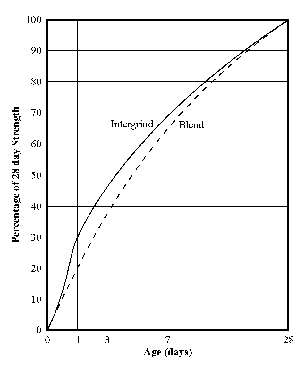ASMS
TECHNICAL NOTE NO 1
Concretes containing ground granulated iron blast-furnace slag as a Portland cement replacement exhibit properties not unlike those containing Portland cement alone.
With the exception of early age strength, most properties are enhanced by the replacement of cement with milled slag. This has resulted in slag blended cements replacing Type GP Portland cement in many applications and the production of special blends to produce properties in concrete not readily achievable with the available Portland cement types.
The data presented for slag cement blends is that available from commercial and research projects. The properties presented include strength, shrinkage, temperature rise and marine and sulphate resistance. Data on ternary blends is also presented.
Introduction
Ground granulated iron blast-furnace slag has been in use in Australia
since the mid-sixties. On the east coast, slag as a cement alternative in the form of
milled slag and in blended cements did not enjoy continuous availability until its
reintroduction in 1982.
In Western Australia, the availability of slag cements has been
uninterrupted since 1970 when milled slag was made available to concrete producers. Slag
cement blends were introduced in 1974 and are currently available from two cement
producers.
Currently, the use of granulated slag as a cement alternative is in high
demand and approximately 250,000 tonnes of granulated slag are manufactured into blended
cements by four cement producers.
Properties of Fresh Concrete Containing Slag
Workability
The lower relative density of ground slag causes an increase in paste
volume. Compared to Portland cement, ground slag occupies about 9% more solid volume for
the same mass. Thus, for equal weight of cement and equal water contents, this increase in
paste volume generally benefits workability in mixes with low cement contents or where the
aggregates lack the fine fraction.
Setting Time
The setting times for blended cements are generally longer than for
Portland cements. As the percentage of slag increases in the blended cement or the
concrete the setting or stiffening time extends. An increase in slag content from 35% to
65% increases initial set by approximately 60 minutes.
The delayed setting of blended cements allows concrete to be worked for
longer periods. This is of benefit in avoiding formation of cold joints in large pours and
in hot weather concreting.
Bleeding
The bleeding capacity and bleeding rate of concrete is affected by the
ratio of the surface area of solids to the unit volume of water. When slag is used as a
cement replacement, these effects depend on the fineness of the slag compared to the
Portland cement and the combined effect of the total cementitious material.
If the slag is finer than the Portland cement, and substituted on an
equal basis, bleeding is reduced. Conversely, if the slag is coarser, the rate of bleed
increases. Blended cements containing slag and manufactured by the intergrinding process
generally cause a reduction in bleeding tendency.
Properties of Hardened Concrete Containing Slag
Compressive Strength
It has been generally shown that concretes containing ground granulated
blast-furnace slag as a cement replacement, at normal temperatures, develop strengths more
slowly than that made from Portland cement [1-4].
The degree of decline in early age strength is a function of a number of
variables. These include slag activity [5,6], method of proportioning and the slag content
of the blend.
Slag blends manufactured by collective comminution, produce concretes
with higher early strengths than concretes produced by blending the separate components.
Figure 1 demonstrates the rate of strength development of the two types of blended
cements. In each case the clinker component was identical and slag contents were 35% by
mass.
Figure 1: Rate of strength gain
At early ages, the mode of manufacture of the blended cement can cause a
difference of up to 10% in compressive strength for the same binder contents. This
difference is of course dependent on the fineness of the cement and the slag as well as
the reactivity of the two components.
Slag cements in current use produce concretes of equivalent 28 day
compressive strengths for equal mass replacements of Portland cement. Slag contents are
nominally at 25% by mass.
At normal curing temperatures, the slag component reacts at a slower
rate than does Portland cement resulting in a lower compressive strength at 7 days. Figure
2 shows the difference in strengths for concretes containing binder contents between 300
and 450 kg/m3 and 80 mm slump.
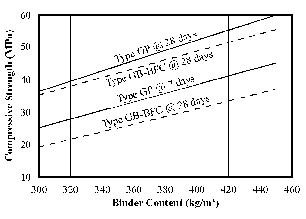
Figure 2: Compressive Strength Performance
Higher replacement rates of slag for equal binder contents reduces
strength at all ages as shown in Figure 3. This appears to be due to non-optimum gypsum
contents particularly at replacement rates in excess of 50% [7].
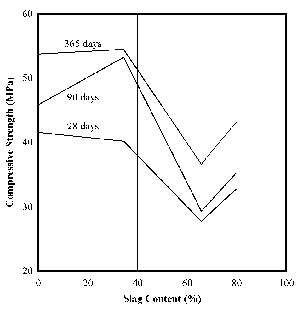
Figure 3: Influence of Slag Content on Compressive Strength
Replacement rates above 40% by mass tend to produce concretes that
exhibit low heat concrete behaviour. Data for a 30 MPa concrete mix design is presented in
Table 1 and Figure 4. Air cooled slag was used as an aggregate.
Table 1: Effect of binder composition
Mix Number |
1 |
2 |
3 |
4 |
Aggregate Type |
Slag |
Slag |
Slag |
Slag |
Cement Type |
LH |
ACSE |
ACSE |
ACSE |
Admixture |
300R |
300R |
300R |
300R |
Portland Cement Ground Slag Fly Ash 40 mm 20 mm 10 mm Coarse Sand Fine Sand |
405 - - 385 325 325 530 225 |
205 205 - 390 330 330 510 220 |
205 140 60 385 325 325 500 215 |
305 - 100 385 325 325 510 220 |
W/C Ratio Slump (mm) Air Content (%) |
0.39 80 1.0 |
0.40 80 0.9 |
0.41 95 0.9 |
0.43 95 1.0 |
Comp Strength (MPa) 7 day 14 day 28 day |
50.0 60.5 |
53.5 59.5 |
47.5 55.0 |
46.5 54.5 |
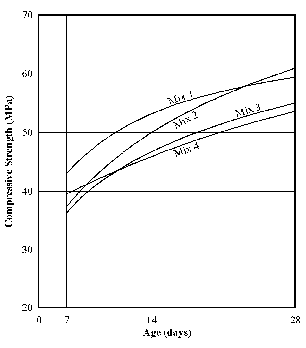
Figure 4: Effect of binder
Flexural Strength
Blended cements containing slag generally yield higher moduli of rupture
at ages beyond 7 days than do concretes without slag, particularly when slag is used at
optimum proportions [6]. This is thought to be a result of the increased denseness of the
paste in the concrete [8].
Drying Shrinkage
It is well documented in literature [9] that creep and shrinkage are related to he
sulphate (gypsum) content of cement, and to cement chemistry and fineness.
The effect of slag content on drying shrinkage is shown in Figure 5. For 40 MPa
concrete with slag contents varied between 0% and 80% by mass, the drying shrinkage:
1. increased by 11% at 14 days;
2. increased by 10% at 56 days; and
3. decreased by 7% at 365 days.
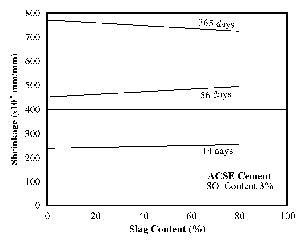
Figure 5: Influence of slag content on drying shrinkage
It follows that as slag replacement increases in the binder, there is a dilution of the
sulphate content in the binder, causing higher volume changes to occur. The optimum
sulphate level is that associated with the lower volume changes of concrete containing the
cement alone.
Figure 6 demonstrates the effect of sulphate content on drying shrinkage for a binder
containing 35% slag [7].

Figure 6: Influence of gypsum content on drying shrinkage
Creep
The influence of sulphate content on creep is shown in Figure 7. It can be seen that as
the sulphate content increases, creep decreases. However, there does not appear to be an
optimum sulphate content for creep as had been suggested by Alexander et al [9].
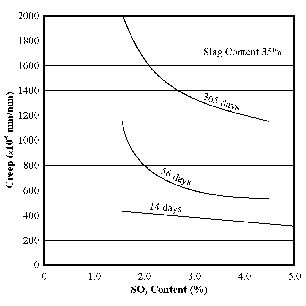
Figure 7: Effect of gypsum content on creep
Increasing slag content decreases creep. The effect of slag content in a 40 MPa
concrete mix is shown in Figure 8.
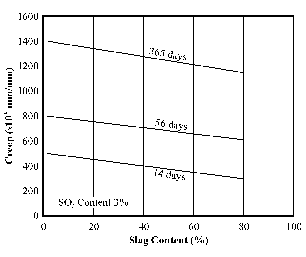
Figure 8: Influence of slag content on creep
Thermal Cracking
Granulated slags and fly ashes have been commonly used as ingredients of blended
cements as separate cementitious constituents to reduce the temperature rise in mass
concrete.
It is important to note that, although the heat of solution method for determining the
heat of hydration of cements indicates the total heat release potential of cement, it
unfortunately does not indicate the rate of temperature rise, which is important in mass
concrete applications.
Early age cracking occurs when the restrained strain during cooling exceeds the tensile
strain capacity [10]. The restrained strain is the product of the coefficient of
thermal expansion, the fall in temperature during cooling and the restraint
factor [10].
Blended cements have a negligible effect on the coefficient of thermal expansion and
the restraint factor, however, they do effect the temperature fall and reduce the tensile
strain capacity of the concrete at early ages.
Ground granulated slag reduces the temperature rise and hence the temperature fall in
comparison to Portland cement in concrete of equal strength grade. CIRIA Report 91 states
that in large concrete pours the reduction in temperature fall is about 9% with 40% slag
replacement and about 35% with 70% slag replacement [10]. The degree of temperature
reduction is also dependent on the reactivities of the slag and of the cement used [6].
Comparison of temperature rise and temperature cycles in concrete under adiabatic
conditions have demonstrated significant differences when blended cements are employed.
The effect of slag replacement is shown in Figure 9, 10 and 11 [13].
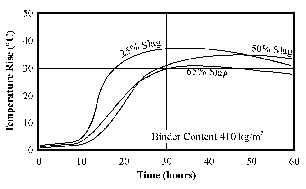
Figure 9: Temperature rise in concrete (slag, aggregate and ACSE cement)

Figure 10: Temperature / time curves under adiabatic conditions
Resistance to Sulphate Attack
Generally, slag cement concretes have been shown to have a higher level of sulphate
resistance than Portland cement concrete. Frearson [14] found that even mortars containing
30% slag replacement were more resistant to sulphate attack than mortars made from
Portland cement alone.
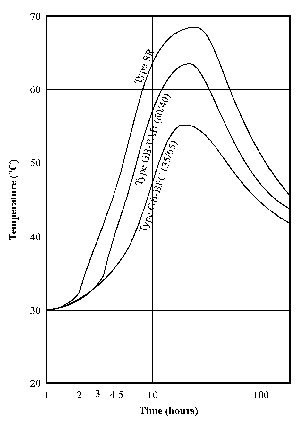
Figure 11: Comparison of calculated temperature cycles at centre of 500 mm
slab for all cements
Comparative tests have shown that as slag replacement increases, slag cements acquire
sulphate resistance similar to and in some cases exceeding that of sulphate resisting
Portland cements. This is demonstrated in Figure 12.
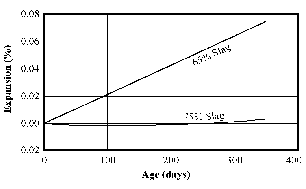
Figure 12: Effect of slag content on expansion of mortar prisms (Type GP -
slag blends)
The reason for the better performance of slag blends compared to Portland cement is
unclear. It is thought that the performance is associated with the lowering of the C3A level in the concrete, reduction in the concentration of
soluble calcium hydroxide in the paste matrix due to the reaction with the slag and
changes to the internal pore structure of the paste [8].
It must be pointed out that the use of sulphate resisting cement or slag
blends in concrete does not of itself confer immunity from sulphate attack. Low
water/binder ratios and sufficient binder contents are essential for satisfactory
performance. Vervbeck showed that water/cement ratio (cement content) is a significant
factor [15].
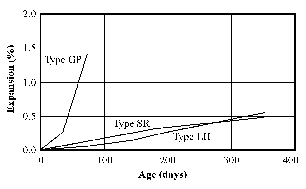
Figure 13: Effect of cement type on the expansion of mortar
prisms
Chloride Penetration
There is much evidence to support the belief that slag cements have
higher resistance to diffusivity of chloride ions than do Portland cements [8, 16, 17,
18].
There is a suggestion that this is not due simply to reduction in
impermeability and may be due to some form of chemical resistance or interaction with the
entering chloride ions at the surface of the hydrating paste. This increase in resistance
to chloride penetration improves as the slag replacement ratio increases.
Smolczyk [16] found that even at high water/binder ratios, high slag
blends presented resistance to ingress of chlorides (see Figure 14).

Figure 14: Chloride-diffusion in concrete bars
Investigations [19] undertaken at the National Building Technology
Centre in Sydney confirm overseas data for local materials. Lower levels of chloride
penetration were obtained with three types of cement when slag replacement was greater
than 60% by mass. Data is presented in Figure 15.
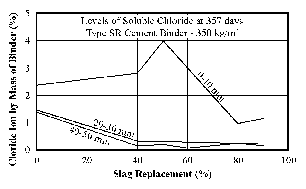
Figure 15: Effect of slag replacement
Durability
Carbonation
The rate of carbonation of slag cement concrete has been reported to be higher than that of Portland cement concrete, especially at high slag replacement values. In all cases, the rate of carbonation is related directly to the compressive strength of concrete [11].
Concretes stored in water or subjected to continuous moist curing, to
reach their designed strength, generally show little or no carbonation [11]. In high
quality concrete the penetration may only be 5 mm in 50 years of exposure [12].
This demonstrates the necessity for proper curing of all concrete.
Mather found that cessation of curing at 3 days caused both slag cements and Portland
cements to suffer strength loss to the same degree [20]. Thus for concrete when originally
exposed, the carbonation depth is likely to be the same whether the binder contains slag
blend or a Portland cement [16].
Sorptivity
Ho et al showed that concrete quality with response to interrupted curing is improved by the incorporation of slag in concrete [21].
The rate of water absorption by capillary action is significantly decreased when slag is used at replacement values of 35%. Sorptivity values for slag concretes were found to be similar to higher strength plain concretes. As the compressive strength of the concrete increases the influence of constituents reduces.
Properties of Ternary Blends
Ternary cements were first used in Australia in September 1966 by Specified Concrete Pty Ltd in Wollongong [22]. The cement binder was plant mixed and consisted of 40% Portland cement, 40% ground granulated slag and 20% fly ash. In March 1967, Australian Iron and Steel Pty Limited allowed the use of ternary cement in all concrete supplied to the steelworks.
In Sydney, the use of plant mixed ternary blends has been associated with the major concrete producers. The ternary binder is produced by adding fly ash to concrete containing slag cement blend. The quantity of fly ash incorporated depends on the mix philosophy employed and the grade of concrete being produced.
Typical binder contents and compressive strength results for commercial
concrete are presented in Table 2. The data represents a production period of ten months.
Table 2: Composition and compressive strength of concrete containing ternary blend
Strength Grade |
Content (kg/m3) |
Compressive Strength (MPa) |
||
Slag Blend |
Fly Ash |
7 Day |
28 Day |
|
20 MPa 25 MPa 30 MPa 32 MPa 35 MPa 40 MPa |
230 260 305 320 350 405 |
100 90 90 90 80 70 |
12.0 16.5 24.0 26.0 27.5 31.0 |
24.5 30.5 40.0 43.0 43.0 44.5 |
Concrete Workability
Field results indicate that concrete containing ternary blends can be
handled at lower slumps. Finishability is also reported to be better than for concrete
where Portland cement alone is used.
Although both of these properties are affected by mix design, the increase in paste
volume resulting from use of ternary blends, appears to improve workability and
pumpability.
Setting Time
Blended cements generally cause setting times of concrete to increase. As the Portland
cement content in the binder decreases, concrete setting time increases.
For ternary cement blends, this effect is similar to other blended cements. The
increase in setting time being a function of binder composition. Typical values for
concretes containing the same mass of binders, but of different composition, are presented
in Table 3.
This effect on setting time generally decreases when suitable chemical admixtures are
used in the concrete.
Table 3: Effect of binder composition on setting time for concrete containing 295 kg/m3 of binder
Proctor |
Ternary Blend Composition |
||
Setting Time (mins) |
40% GP 40% Slag 20% Ash |
50% GP 30% Slag 20% Ash |
55% GP 30% Slag 15% Ash |
Initial |
136 |
123 |
115 |
Final |
159 |
138 |
128 |
Strength Gain
For concretes containing equal masses of binder, the rate of strength gain for ternary
blends is less than for Type GP cement at all early ages. This is shown in Figure 16. The
rate of strength gain of ternary blends compared to that of Type GP Portland cement is
demonstrated in Figure 17.

Figure 16: Rate of strength gain
Drying Shrinkage
There appears to be no significant difference in drying shrinkage between concretes
containing ternary blends or those made with Type GP Portland cement.
The effect of binder composition on drying shrinkage is presented for 20 MPa and 40 MPa
concretes in Figure 18 and 19.

Figure 17: Rate of strength gain compared to Type GP
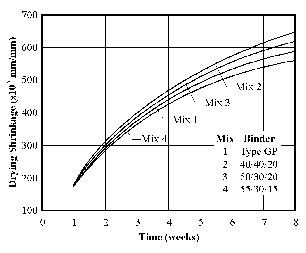
Figure 18: Drying shrinkage (20 MPa concrete)

Figure 19: Drying shrinkage (40 MPa concrete)
Conclusions
The use of ground granulated blast-furnace slag in concrete allows the
design of cements which provide the required concrete properties to suit the application
required by the engineer.
To fully utilise slag cements, engineers and specifiers must acquire an
understanding of the properties, potential and limitations of these materials.
Although slag cement concretes offer many attractive advantages,
compared to Portland cement concretes, there are situations where they may not be the most
appropriate materials.
References
1. Wainwright PJ and Tolloczko JJA, "Early and Later Age Properties
of Temperature Cycled Slag-OPC Concretes", Second International Conference on Use
of Fly Ash, Silica Fume, Slag and Natural Pozzolans in Concrete, Vol 2, Madrid, Spain,
1986.
2. Cook DJ, Hinczak I and Cao HT, "Development of Strength and
Microstructure in BFS/OPC Blends", Concrete 87, Cement and Concrete
Association, Brisbane, Australia, June 1987.
3. Reeves CM, "The Use of Ground Granulated Blast-furnace Slag to
Produce Durable Concrete", How to Make Today's Concrete Durable for Tomorrow,
Thomas Telford, London, May 1985.
4. Douglas E and Zebino R, "Characterisation of Granulated and
Pelletized Blast-furnace Slag", Cement and Concrete Research, Vol 16, 1986.
5. Frearson JPH and Uren JM, "Investigations of Ground Granulated
Blast-furnace Slag Containing Merwinitic Crystallisation", Second International
Conference on Use of Fly Ash, Silica Fume, Slag and Natural Pozzolans in Concrete, Vol
2, Madrid, Spain, 1986.
6. Cook DJ Hinczak I. and Cao HT, "Heat of Hydration, Strength, and
Morphological Development in Blast-furnace/Cement Blends", International Workshop
on Granulated Blast-Furnace Slag in Concrete, Toronto, Canada, 1987.
7. Cook DJ, Hinczak I and Duggan R, "Volume Changes in Portland
Blast-furnace Slag Cement Concrete", Second International Conference on Use of Fly
Ash, Silica Fume, Slag and Natural Pozzolans in Concrete, Madrid, Spain, 1986.
8. Bakker RFM, "Permeability of Blended Cement Concretes", ACI
SP 79-21, 1983.
9. Alexander KM, Wardlaw J and Ivanusec I, "The Influence of SO3 Content of Portland Cement on the Creep and Other
Physical Properties of Concrete", Cement and Concrete Research, Vol 9, 1979.
10. Harrison TA, "Early-age Thermal Crack Control in
Concrete", CIRIA Report 91, Construction Industry Research and Investigation
Association London, 1981.
11. Osborne GJ, "Carbonation of Blast-furnace Slag Concretes",
Durability of Building Materials, Vol 4, 1986.
12. Harrison TA and Spooner DC, "The Properties and Use of
Concretes Made with Composite Cements", Interim Technical Note 10, Cement and
Concrete Association, London, 1986.
13. Haywood Engineering Report, 1984.
14. Frearson JPH, "Sulphate Resistance of Combinations of Portland
Cement and Ground Granulated Blast-furnace Slag", Second International Conference
on Use of Fly Ash, Silica Fume, Slag and Natural Pozzolans in Concrete, Vol 2, Madrid,
Spain, 1986.
15. Verbeck G, "Field and Laboratory Studies of the Sulphate
Resistance of Concrete", Performance of Concrete - Resistance of Concrete to
Sulphate and Other Environmental Conditions, University of Toronto Press, 1968.
16. Smolczyk HG, "Die Verwendung Von Hochofenzement Fur Stahlbeton
Und Spannbeton", VI International Steelmaking Day, Paris, France, 1977.
17. Gjorv OE and Vennesland O, "Diffusion of Chloride Ions From
Seawater Into Concrete", Cement and Concrete Research, Vol 9, 1979.
18. Roy DM and Idorn GM, "Hydration, Structure and Properties of
Blast-furnace Slag Cements, Mortars and Concretes", ACI Journal, No 97, 1982.
19. Progress Report to Blue Circle Souther Cement Limited, "Marine and Sulphate Resistance of Blended Cements", National Building Technology Centre, Sydney, 1987.
20. Mather B, "Laboratory Test of Portland Blast-furnace Slag
Cements", Journal of the American Concrete Institute, 1957.
21. Ho DWS, Hinczak I, Conroy JJ and Lewis RK, "Influence of Slag
Cement on the Water Sorptivity of Concrete", Second International Conference on
Use of Fly Ash, Silica Fume, Slag and Natural Pozzolans in Concrete, Vol 2, Madrid,
Spain, 1986.
22. Private Correspondence - Mr J Visek, Consultant.
Ihor Hinczak
Please use your BACK button to return to the last page.
© Copyright 1996 QCL Group
ACN 009 658 520
Permission to display page on DPPEA site requested 3/6/98.
